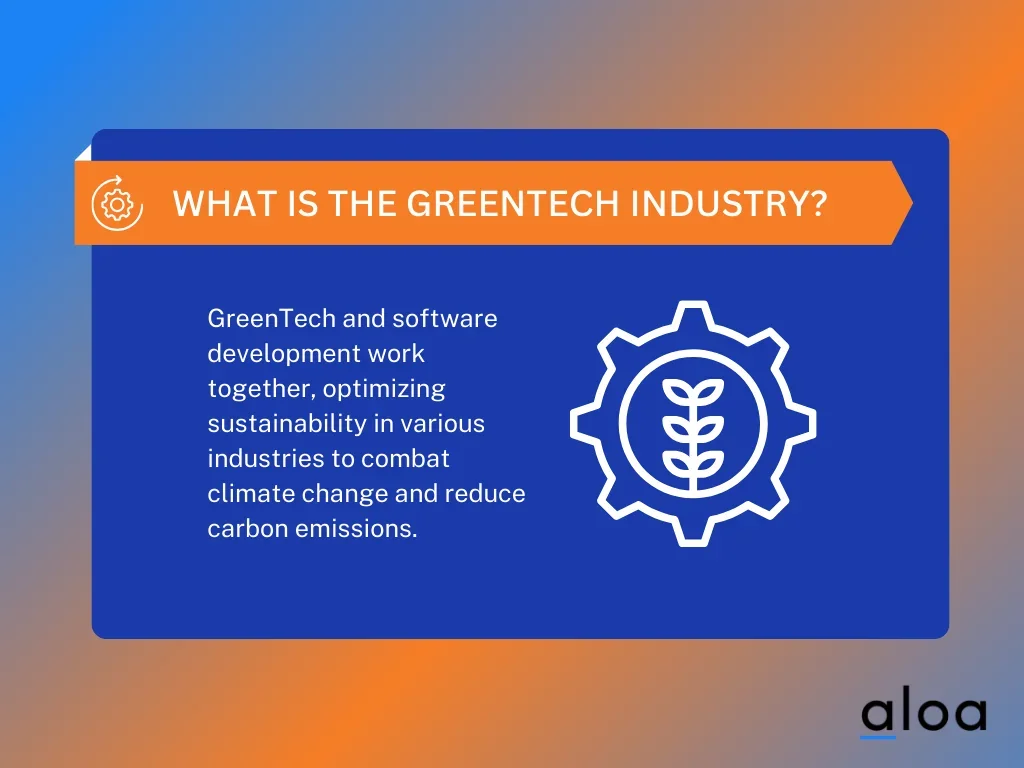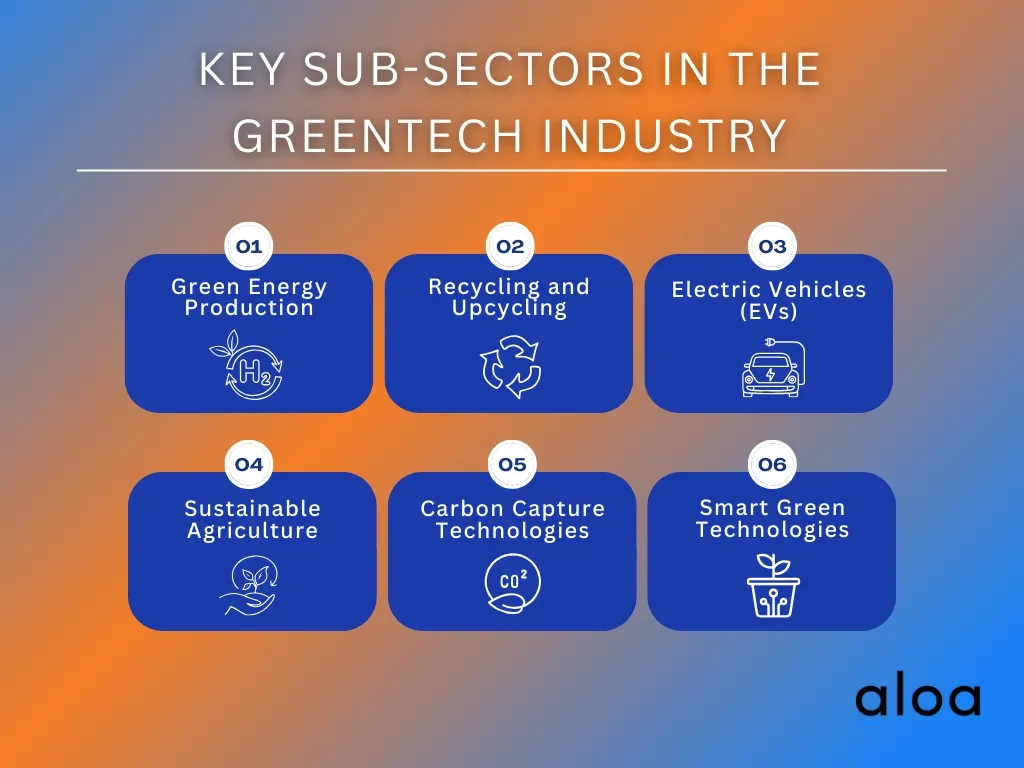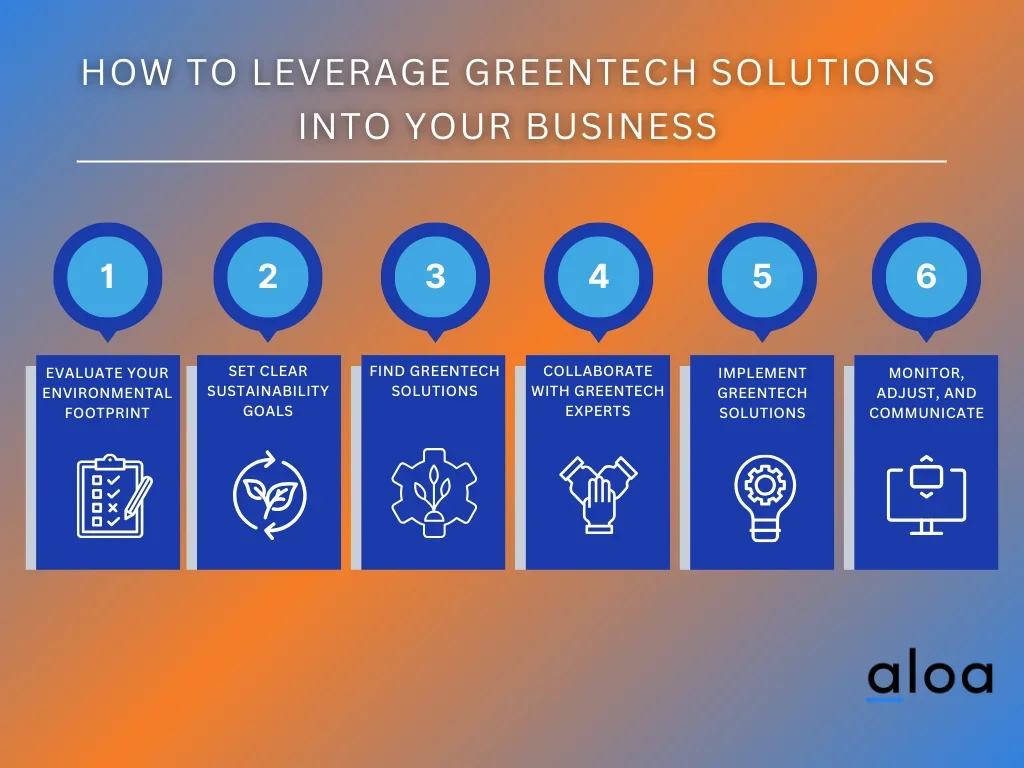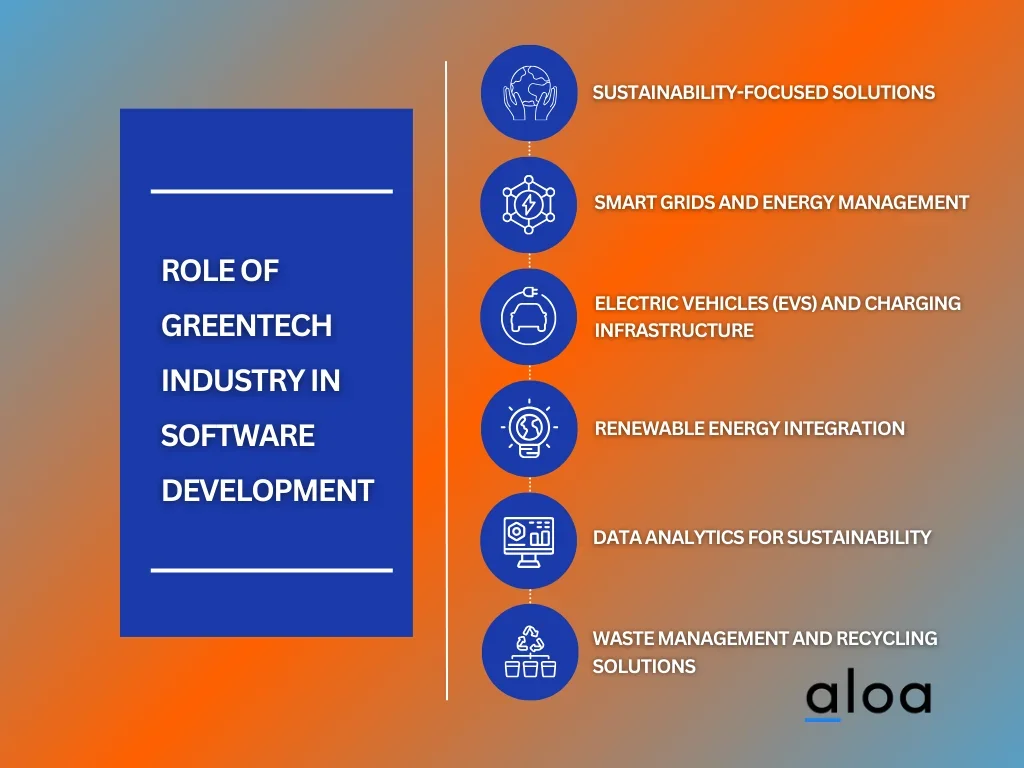The GreenTech industry is powering a sustainable future and driving innovation towards a greener planet. Startups and businesses recognize the importance of GreenTech in addressing climate change and reducing carbon emissions. However, they often face challenges integrating GreenTech solutions into their operations, especially in software development.
Aloa helps businesses and startups navigate these challenges by providing tailored software solutions that align with their GreenTech initiatives. Our expertise ensures that software systems efficiently manage renewable energy production, electric vehicles, and sustainable agriculture technologies. We optimize energy consumption and facilitate carbon capture, contributing to a more sustainable world.
In this comprehensive guide, we will explore the diverse landscape of the GreenTech industry, shedding light on sub-sectors. We'll discuss how these technologies are catalysts for change and examine the crucial role of software development in their success.
By the end of this blog, you will have gained valuable insights into the GreenTech industry and discovered a potential role for your business to thrive in 2023.
Let's dive in!
What is the GreenTech Industry?

GreenTech comprises innovative and environmentally friendly technologies designed to reduce carbon emissions, conserve resources, and promote sustainability. It fights against climate change and reduces our reliance on fossil fuels. This GreenTech industry sector encompasses many solutions, including solar panels, wind turbines, electric vehicles, and more.
GreenTech and software development share a symbiotic relationship. Software plays a pivotal role in optimizing the performance and efficiency of GreenTech solutions. It enables real-time monitoring, data analysis, and control systems, making renewable energy sources more predictable and manageable.
In software development, it empowers the creation of smart grids, energy management systems, and sustainable supply chain solutions. Green technology companies are at the forefront of innovation and sustainability, making significant contributions to a greener and more sustainable future both in the United States and globally. They are revolutionizing various industries with their groundbreaking solutions.
Key Sub-Sectors in the GreenTech Industry
The GreenTech industry stands at the forefront of the global effort to combat climate change, reduce carbon emissions, and build a more sustainable future. Let’s dive deep into the critical sub-sectors within the GreenTech industry, shedding light on their significance, potential impact, and the opportunities they offer to startups and businesses in 2023.

Green Energy Production
Green energy production is the bedrock of the GreenTech industry, representing a fundamental shift away from traditional fossil fuels towards clean, renewable energy sources. These technologies play a crucial role in decreasing our dependency on fossil fuels and minimizing the severe impacts of climate change.
Over the years, green energy production technologies have undergone significant advances. These innovations have made renewable energy sources more accessible and cost-effective for consumers and businesses. The development of solar panels, wind turbines, and other innovative solutions has played a crucial role in driving the widespread adoption of clean energy.
Use Cases of Green Energy Production
- Solar Power: Solar panels harness the energy from the sun, enabling electricity generation for homes and businesses. Solar farms and solar-powered gadgets are becoming increasingly common.
- Wind Power: Wind turbines harness the power of wind by capturing its kinetic energy and transforming it into electricity. Wind power is being harnessed on a large scale in wind farms.
- Hydropower: Electricity can be generated using the energy from flowing water, and hydropower plants are crucial in producing clean energy.
- Geothermal Energy: This energy taps into the Earth's natural heat, providing a consistent and sustainable power source.
Businesses investing in green energy production should carefully evaluate factors like efficiency, maintenance requirements, scalability, and the geographical suitability of these technologies. Additionally, government incentives and subsidies can significantly impact the economic viability of such projects.
Recycling and Upcycling
Recycling and upcycling technologies are essential components of the GreenTech industry, as they play a pivotal role in reducing waste, conserving resources, and minimizing the environmental footprint of various industries.
Recycling and upcycling encompass many processes and innovations, from traditional recycling methods to cutting-edge technologies that transform waste materials into valuable products.
Use Cases of Recycling and Upcycling
- Waste-to-Energy Conversion: Technologies that convert waste materials into electricity or heat, effectively reducing waste while producing energy.
- Plastic Recycling: Innovative methods for recycling plastics are essential in combating plastic pollution and promoting sustainable packaging solutions.
- Circular Economy Models: These models emphasize a sustainable approach where materials are continuously recycled and reused, reducing the need for new resource extraction.
For businesses involved in recycling and upcycling, navigating the complex landscape of regulatory requirements is crucial. Establishing partnerships with waste management companies to ensure a consistent supply of materials is also a key consideration.
Electric Vehicles (EVs)
The emergence and rapid adoption of electric vehicles (EVs) represent a transformative shift in the automotive industry. Electric vehicles (EVs) are specifically designed to operate using electricity rather than relying on conventional fossil fuels. This innovative approach provides a cleaner and more sustainable mode of transportation.
The global push towards reducing carbon emissions and dependence on oil has accelerated the development and adoption of electric vehicles.
Use Cases of Electric Vehicles (EVs)
- Battery Technology: Continuous advancements in battery technology have led to longer ranges, faster charging times, and improved overall performance for EVs.
- Charging Infrastructure: A robust EV charging infrastructure is essential to support the widespread adoption of electric vehicles.
- Commercial EVs: Beyond personal use, electric options for buses, trucks, and delivery vehicles are transforming the commercial transportation sector.
Businesses contemplating entry into the EV market should carefully assess factors like battery range, availability and accessibility of charging infrastructure, and the regulatory environment, which can significantly impact the growth and success of EV ventures.
Sustainable Agriculture
Sustainable agriculture fuses technology and eco-friendly practices to enhance food production while minimizing the ecological footprint. This sub-sector addresses the challenges of food security and resource preservation in the face of a growing global population.
Sustainable agriculture practices encompass precision farming, organic cultivation methods, and the strategic use of technology to optimize crop yields and minimize environmental impact.
Use Cases of Sustainable Agriculture
- Precision Farming: Integrating data and technology in agriculture enables farmers to make informed decisions, optimize resource allocation, and reduce waste.
- Vertical Farming: Innovative approaches to crop cultivation, such as vertical farming in controlled environments, conserve space and resources.
- Organic Farming: Sustainable practices in organic farming prioritize reducing chemical inputs, promoting soil health, and delivering eco-friendly produce.
Businesses venturing into sustainable agriculture must evaluate the potential for precision farming tools, the adoption of sustainable crop cultivation practices, and the ability to access markets that value eco-friendly produce.
Carbon Capture Technologies
Carbon capture technologies are pivotal in the global fight against climate change. These technologies involve capturing carbon dioxide emissions from industrial processes or power generation, either for storage or repurposing.
Carbon capture technologies hold great promise in reducing greenhouse gas emissions and aiding industries in their shift towards cleaner energy sources.
Use Cases of Carbon Capture Technologies
- Direct Air Capture: Technologies designed to capture carbon dioxide directly from the atmosphere.
- Carbon Utilization: Innovative applications that transform captured carbon dioxide into valuable products, creating economic incentives for carbon capture.
- Carbon Storage: Safely storing captured carbon dioxide underground, preventing its release into the atmosphere.
Businesses exploring carbon capture should carefully assess the feasibility of implementation, associated costs, and potential revenue streams from repurposing captured carbon, which can vary depending on regional policies and market demand.
Smart Green Technologies
The convergence of smart green technologies brings together the power of digitalization with sustainability, creating intelligent systems that optimize resource usage and reduce environmental impact.
The intersection of IoT (Internet of Things) technology and sustainability has given rise to smart green solutions that enhance efficiency and promote sustainability.
Use Cases of Smart Green Technologies
- Smart Grids: Intelligent energy distribution systems that balance supply and demand for enhanced energy efficiency.
- Energy Management Systems: Real-time monitoring and optimization technologies for businesses and individuals to manage their energy consumption.
- Environmental Monitoring: The deployment of sensors and data analytics for tracking environmental parameters, including air quality and water management.
Businesses considering the adoption of smart green technologies should assess the scalability of these solutions, prioritize data security, and remain compliant with emerging regulations governing IoT and sustainability.
How to Leverage GreenTech Solutions Into Your Business
GreenTech is a powerful ally for companies aiming to reduce their carbon footprint, lower operational costs, and contribute to a sustainable future. Let’s explore a step-by-step guide on how to leverage GreenTech solutions in your business and make a positive impact on both your bottom line and the planet.

Step 1: Assess Your Current Environmental Impact
Before diving into GreenTech solutions, it's essential to understand your company's current environmental impact. Conduct an eco-audit to identify areas where your business consumes energy and resources. This audit can encompass electricity usage, water consumption, waste generation, and carbon emissions. The data you gather will serve as a baseline to measure the effectiveness of your GreenTech initiatives.
Step 2: Set Clear Sustainability Goals
Once you grasp your environmental footprint, it's time to establish clear sustainability goals. Determine what you want to achieve with GreenTech solutions. These objectives include reducing energy consumption by a certain percentage, achieving zero-waste production, or implementing a green supply chain strategy. Setting specific, measurable, and time-bound goals will guide your GreenTech implementation.
Step 3: Identify Suitable GreenTech Solutions
Now that your sustainability goals are in place, it's time to explore GreenTech solutions that align with your objectives. Consider the following areas:
- Energy Efficiency: Invest in energy-efficient appliances, LED lighting, and smart building management systems to reduce electricity consumption.
- Renewable Energy: Consider implementing renewable energy sources like solar panels or wind turbines to generate clean and sustainable energy directly at your location.
- Waste Management: Implement recycling and waste reduction programs to minimize landfill contributions.
- Green Transportation: Introduce electric vehicles (EVs) to your fleet or incentivize employees to commute using public transport or carpooling.
- Sustainable Supply Chain: Partner with eco-conscious suppliers and adopt sustainable packaging practices.
Step 4: Collaborate with GreenTech Experts
Leveraging GreenTech solutions often requires specialized knowledge and expertise. Consider partnering with organizations like Aloa, a trusted development partner specializing in GreenTech solutions. Collaborating with such experts can streamline the implementation process, ensure regulation compliance, and provide access to cutting-edge technologies.
Step 5: Implement GreenTech Solutions
With your GreenTech solutions identified and your development partner on board, it's time to implement the changes. This step may involve retrofitting your facilities with energy-efficient equipment, installing renewable energy systems, or overhauling your waste management processes. Be prepared for some upfront costs, but remember that the long-term benefits outweigh these expenses.
Step 6: Monitor, Adjust, and Communicate
Once your GreenTech solutions are in place, the journey is far from over. Continuously monitor your sustainability metrics to track progress toward your goals. Analyze data to identify areas for further improvement. Adjust your strategies as needed to maximize efficiency and reduce environmental impact.
Moreover, effective communication is vital. Share your sustainability achievements with customers, employees, and investors. Demonstrating your commitment to GreenTech enhances your brand reputation and can attract environmentally conscious consumers and investors.
Role of GreenTech Industry in Software Development
With its commitment to sustainability and environmental responsibility, the GreenTech industry transforms how we interact with our environment and shapes the software development landscape. Let’s delve into the crucial role of the GreenTech industry in driving innovation and change in software development.

Sustainability-Focused Solutions
One of the primary ways the GreenTech industry influences software development is by demanding sustainability-focused solutions. As businesses adopt eco-friendly practices, software developers are tasked with creating applications and systems that align with these values. Whether designing energy-efficient algorithms, optimizing data centers for minimal environmental impact, or creating software for managing renewable energy grids, software development is pivotal in implementing and enhancing sustainability initiatives.
Smart Grids and Energy Management
GreenTech innovations such as smart grids and advanced energy management systems rely heavily on software development. These technologies enable efficient energy distribution, consumption monitoring, and grid management.
Software developers play a crucial role in building the algorithms and platforms that allow real-time data analysis, enabling utilities to balance energy supply and demand effectively. By reducing energy waste, this practice not only helps to conserve energy but also facilitates the integration of renewable energy sources into the power grid.
Electric Vehicles (EVs) and Charging Infrastructure
The rise of electric vehicles is a significant aspect of the GreenTech revolution. Software developers are essential in creating user-friendly interfaces for EV charging stations, developing apps for EV owners to locate charging stations and designing predictive maintenance software for EV fleets. These software solutions enhance the convenience and accessibility of EVs, which, in turn, promotes cleaner transportation options. One of the critical advancements in this area is EV charging mobile app development, which not only helps EV owners find nearby charging stations but also integrates features that optimize charging times and manage energy consumption efficiently.
Renewable Energy Integration
Software development is pivotal in integrating renewable energy sources into the energy grid. This involves creating predictive algorithms to forecast renewable energy generation, optimizing energy storage systems, and developing control software for renewable energy installations.
In the GreenTech industry, software solutions play a crucial role in enhancing the efficiency and reliability of renewable energy generation. This makes it a promising alternative to conventional energy sources. Collaborating with a renewable energy software company can further enhance these capabilities, providing customized software solutions that optimize energy production, storage, and distribution for a more sustainable future.
Data Analytics for Sustainability
Data analytics is at the heart of the GreenTech industry's efforts to reduce environmental impact. Software developers have the important responsibility of creating advanced data analytics tools. These tools can handle large volumes of data from diverse sources such as sensors, satellites, and weather stations.
Businesses and governments gain valuable insights into environmental patterns by analyzing this data. This information helps them make informed decisions regarding resource management, pollution control, and efforts to mitigate climate change.
Waste Management and Recycling Solutions
Software development is crucial in waste management and recycling in the GreenTech industry. Automated waste sorting systems, recycling optimization software, and logistics platforms for waste collection rely on software solutions. These technologies improve the efficiency of recycling and reduce the environmental impact of waste disposal.
Environmental Monitoring and Reporting
Environmental monitoring and reporting are essential for assessing the impact of human activities on the environment. Software developers create monitoring systems that collect data on air quality, water quality, and other environmental parameters. These systems offer timely information that can be utilized for ensuring regulatory compliance, detecting environmental concerns in advance, and making well-informed decisions based on evidence.
Key Takeaway
The GreenTech industry in 2023 is teeming with opportunities that startups and businesses should seize. Embracing GreenTech solutions is not just a choice but a strategic imperative. By implementing GreenTech, businesses can significantly reduce their carbon footprint, bolster their sustainability credentials, and tap into an increasing market driven by eco-conscious consumers and government incentives. This industry offers an array of possibilities, from solar power and electric vehicles to waste management innovations and renewable energy sources.
GreenTech goes beyond environmental responsibility; it's about ensuring the longevity of your business. With the growing global emphasis on sustainability, failure to adapt puts enterprises at risk of becoming obsolete. Businesses and startups must explore how GreenTech can transform their operations, drive cost efficiencies, and gain a competitive edge.
You can contact [email protected] for guidance and support to start your transformative journey. The GreenTech revolution is calling, and this is your chance to thrive in a greener and more prosperous future.

